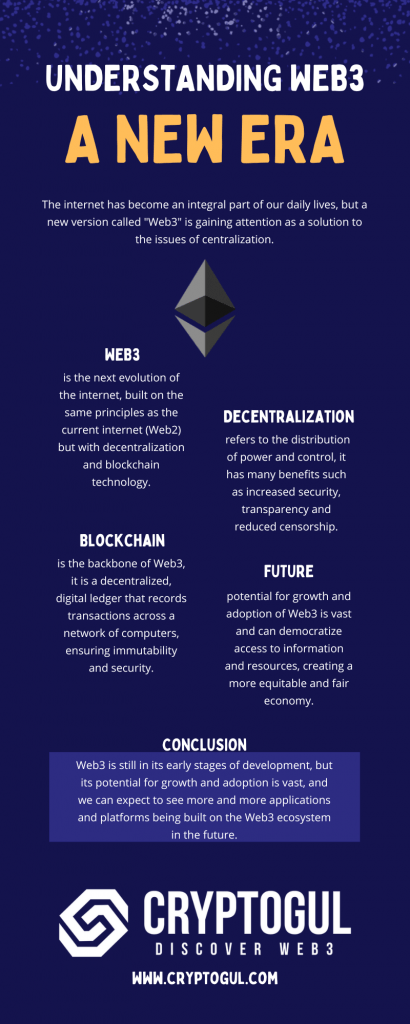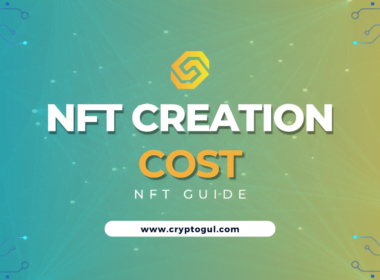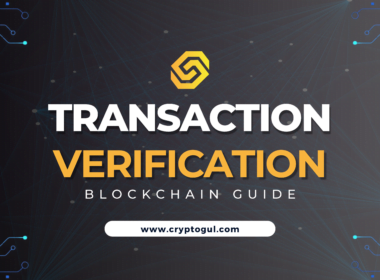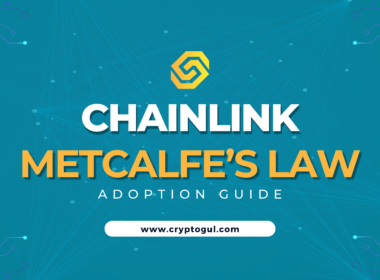The internet has become an integral part of our daily lives, connecting us to information, people, and resources all over the world.
However, as the internet has evolved, it has also become increasingly centralized, with a few large companies controlling the flow of information and data. A new version of the internet, known as “Web3,” is gaining attention as a solution to these issues.
The purpose of this article is to explain Web3 to beginners and its potential to revolutionize the way we interact and conduct business online.

What is Web3?
Web3, also known as the decentralized web, is the next evolution of the internet. It is built on the same principles as the current internet (Web2), but with a key difference – decentralization.
Unlike Web2, which is controlled by a few large companies, Web3 is built on a network of decentralized nodes. This allows for greater security, transparency, and control for individuals and organizations.
One of the key technologies that makes Web3 possible is blockchain. Blockchain is a decentralized, digital ledger that records transactions across a network of computers.
This technology allows for the creation of digital assets, such as cryptocurrencies, and the execution of smart contracts, which are self-executing contracts with the terms of the agreement written directly into the code.
Web3 is being used in a variety of industries, from finance and gaming to social media. For example, decentralized finance (DeFi) is a rapidly growing sector of the blockchain industry that allows for peer-to-peer lending, borrowing, and trading without the need for intermediaries.
Similarly, blockchain-based gaming platforms are creating new opportunities for players to own and trade in-game items, and decentralized social media platforms are giving users more control over their data and privacy.
The Importance of Decentralization
Decentralization refers to the distribution of power, control, and decision-making away from a central authority. In the context of Web3, this means that there is no single entity controlling the flow of information and data, but rather it is distributed among a network of nodes.
It has many benefits, including increased security and transparency, and reduced censorship. For example, a decentralized network is less vulnerable to hacking and attacks, and it is harder to manipulate or censor the flow of information.
Furthermore, with the use of smart contracts, the transparency is increased, and the trust is built among the parties, reducing the need for intermediaries.
Through this, it is also creating new possibilities for individuals and organizations. For example, blockchain-based platforms are allowing for peer-to-peer transactions, without the need for intermediaries, which reduces transaction fees and increases efficiency.
Additionally, decentralized autonomous organizations (DAOs) are allowing for decentralized decision-making and governance.

Blockchain technology
Blockchain technology is the backbone of Web3. It is a decentralized, digital ledger that records transactions across a network of computers. This means that it is not controlled by any single entity, but rather it is maintained by a network of nodes.
One of the key benefits of blockchain is its immutability. Once a transaction is recorded on the blockchain, it cannot be altered, ensuring that the data is accurate and trustworthy. Additionally, blockchain is secure, as it uses advanced cryptography to protect the data.
Blockchain technology is being used in a variety of ways in the Web3 ecosystem. For example, it is being used to create digital assets, such as cryptocurrencies, which are decentralized and can be bought, sold, and traded without the need for intermediaries.
Additionally, smart contracts, which are self-executing contracts with the terms of the agreement written directly into the code, are being used to automate and streamline a variety of processes, from supply chain management to voting systems.
Furthermore, decentralized finance (DeFi) is a rapidly growing sector of the blockchain industry that allows for peer-to-peer lending, borrowing, and trading without the need for intermediaries.
The Future of Web3
Web3 is still in its early stages of development, but its potential for growth and adoption is vast. As more people become aware of the benefits of decentralization and blockchain technology, we can expect to see more and more applications and platforms being built on the Web3 ecosystem.
One of the most exciting possibilities of Web3 is the potential to democratize access to information and resources. For example, decentralized platforms are giving individuals and small businesses access to the same tools and opportunities that were previously only available to large corporations.
Additionally, Web3 is helping to create a more equitable and fair economy, by reducing the need for intermediaries and increasing transparency.
Conclusion
In conclusion, Web3 is a new version of the internet that is built on the principles of decentralization and blockchain technology.
It has the potential to revolutionize the way we interact and conduct business online, by increasing security, transparency, and control for individuals and organizations.
While Web3 is still in its early stages of development, its potential for growth and adoption is vast, and we can expect to see more and more applications and platforms being built on the Web3 ecosystem in the future.
If you are interested in learning more about Web3 and its possibilities, be sure to check out our education section to discover what you need. But also, there are many resources available online.
Websites such as Ethereum.org, ConsenSys.net, and Web3.foundation provide a wealth of information and resources for those who want to learn more about this exciting new technology.
Additionally, you can also join communities and social media groups dedicated to discussing and exploring Web3.











